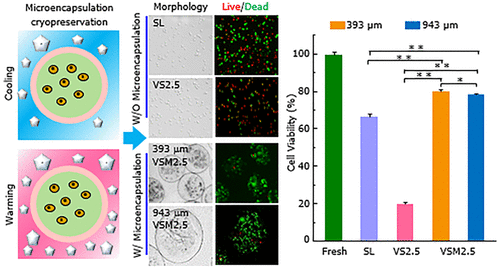当前位置:
X-MOL 学术
›
ACS Biomater. Sci. Eng.
›
论文详情
Our official English website, www.x-mol.net, welcomes your
feedback! (Note: you will need to create a separate account there.)
Microencapsulation Facilitates Low-Cryoprotectant Vitrification of Human Umbilical Vein Endothelial Cells
ACS Biomaterials Science & Engineering ( IF 5.4 ) Pub Date : 2019-09-19 , DOI: 10.1021/acsbiomaterials.9b00726 Yufang Li 1 , Kashan Memon 1 , Yuanyuan Zheng 1 , Yue Cheng 1 , Momoh Karmah Mbogba 1 , Peitao Wang 2 , Xilin Ouyang 3 , Gang Zhao 1
ACS Biomaterials Science & Engineering ( IF 5.4 ) Pub Date : 2019-09-19 , DOI: 10.1021/acsbiomaterials.9b00726 Yufang Li 1 , Kashan Memon 1 , Yuanyuan Zheng 1 , Yue Cheng 1 , Momoh Karmah Mbogba 1 , Peitao Wang 2 , Xilin Ouyang 3 , Gang Zhao 1
Affiliation

|
Vitrification has become one of the promising cryopreservation methods for biosamples including cells and tissues because the vitreous state reduces the damage of ice crystals to cells. However, besides extremely high cooling rates, routine vitrification protocols require a high concentration of penetrating cryoprotectants (pCPAs, ∼6–8 M), which is toxic for cells and brings trouble when removing pCPAs. Therefore, reducing the concentration of toxic pCPAs in vitrification remains a challenge, and advanced strategies are urgently needed. Hydrogel encapsulation has become one effective method to achieve low-cryoprotectant (CPA) concentration preservation of stem cells with rapid cooling, but there are very few related studies about endothelial cells (ECs). In this study, we achieved pCPA concentration (up to 3 M) vitrification by encapsulating human umbilical vein endothelial cells (HUVECs) into core–shell alginate hydrogel microcapsules. Alginate encapsulation increased HUVEC cryosurvival up to 80%, which is 60% improvement compared to control without encapsulation. Furthermore, two different sizes of capsules (diameter: ∼900 and 400 μm) were produced to explore the effects of microcapsule volume on the cell preservation results, and it was found that larger capsules (∼900 μm) have no significant effect on cell survival while improving encapsulation efficiency. This encapsulation method provides a new strategy for EC preservation and serves as an improvement to optimize the preservation of biosamples.
中文翻译:

微囊化促进人类脐静脉内皮细胞的低低温保护玻璃化
玻璃化已成为用于包括细胞和组织的生物样品的有希望的低温保存方法之一,因为玻璃态减少了冰晶对细胞的损害。但是,除了极高的冷却速度外,常规的玻璃化方案还需要高浓度的渗透性防冻剂(pCPAs,约6-8 M),这对细胞是有毒的,并且在去除pCPAs时会带来麻烦。因此,降低玻璃化中有毒pCPAs的浓度仍然是一个挑战,迫切需要先进的策略。水凝胶封装已成为一种在快速冷却下实现干细胞低低温保护(CPA)浓度保存的有效方法,但是关于内皮细胞(EC)的相关研究很少。在这项研究中,通过将人脐静脉内皮细胞(HUVEC)封装到核壳藻酸盐水凝胶微囊中,我们实现了pCPA浓度(高达3 M)的玻璃化。藻酸盐包封可将HUVEC冷冻存活提高至80%,与未包封的对照相比提高了60%。此外,生产了两种不同大小的胶囊(直径:〜900和400μm)以探讨微胶囊体积对细胞保存结果的影响,并且发现较大的胶囊(〜900μm)对细胞存活没有显着影响。同时提高封装效率。这种封装方法为EC的保存提供了新的策略,并作为优化对生物样品的保存的改进。藻酸盐包封可将HUVEC冷冻存活提高至80%,与未包封的对照相比提高了60%。此外,生产了两种不同大小的胶囊(直径:〜900和400μm)以探讨微胶囊体积对细胞保存结果的影响,并且发现较大的胶囊(〜900μm)对细胞存活没有显着影响。同时提高封装效率。这种封装方法为EC的保存提供了新的策略,并作为优化对生物样品的保存的改进。藻酸盐包封可将HUVEC冷冻存活提高至80%,与未包封的对照相比提高了60%。此外,生产了两种不同大小的胶囊(直径:〜900和400μm)以探讨微胶囊体积对细胞保存结果的影响,并且发现较大的胶囊(〜900μm)对细胞存活没有显着影响。同时提高封装效率。这种封装方法为EC的保存提供了新的策略,并作为优化对生物样品的保存的改进。并且发现较大的胶囊(〜900μm)对细胞存活没有显着影响,同时提高了包封效率。这种封装方法为EC的保存提供了新的策略,并作为优化对生物样品的保存的改进。并且发现较大的胶囊(〜900μm)对细胞存活没有显着影响,同时提高了包封效率。这种封装方法为EC的保存提供了新的策略,并作为优化对生物样品的保存的改进。
更新日期:2019-09-20
中文翻译:

微囊化促进人类脐静脉内皮细胞的低低温保护玻璃化
玻璃化已成为用于包括细胞和组织的生物样品的有希望的低温保存方法之一,因为玻璃态减少了冰晶对细胞的损害。但是,除了极高的冷却速度外,常规的玻璃化方案还需要高浓度的渗透性防冻剂(pCPAs,约6-8 M),这对细胞是有毒的,并且在去除pCPAs时会带来麻烦。因此,降低玻璃化中有毒pCPAs的浓度仍然是一个挑战,迫切需要先进的策略。水凝胶封装已成为一种在快速冷却下实现干细胞低低温保护(CPA)浓度保存的有效方法,但是关于内皮细胞(EC)的相关研究很少。在这项研究中,通过将人脐静脉内皮细胞(HUVEC)封装到核壳藻酸盐水凝胶微囊中,我们实现了pCPA浓度(高达3 M)的玻璃化。藻酸盐包封可将HUVEC冷冻存活提高至80%,与未包封的对照相比提高了60%。此外,生产了两种不同大小的胶囊(直径:〜900和400μm)以探讨微胶囊体积对细胞保存结果的影响,并且发现较大的胶囊(〜900μm)对细胞存活没有显着影响。同时提高封装效率。这种封装方法为EC的保存提供了新的策略,并作为优化对生物样品的保存的改进。藻酸盐包封可将HUVEC冷冻存活提高至80%,与未包封的对照相比提高了60%。此外,生产了两种不同大小的胶囊(直径:〜900和400μm)以探讨微胶囊体积对细胞保存结果的影响,并且发现较大的胶囊(〜900μm)对细胞存活没有显着影响。同时提高封装效率。这种封装方法为EC的保存提供了新的策略,并作为优化对生物样品的保存的改进。藻酸盐包封可将HUVEC冷冻存活提高至80%,与未包封的对照相比提高了60%。此外,生产了两种不同大小的胶囊(直径:〜900和400μm)以探讨微胶囊体积对细胞保存结果的影响,并且发现较大的胶囊(〜900μm)对细胞存活没有显着影响。同时提高封装效率。这种封装方法为EC的保存提供了新的策略,并作为优化对生物样品的保存的改进。并且发现较大的胶囊(〜900μm)对细胞存活没有显着影响,同时提高了包封效率。这种封装方法为EC的保存提供了新的策略,并作为优化对生物样品的保存的改进。并且发现较大的胶囊(〜900μm)对细胞存活没有显着影响,同时提高了包封效率。这种封装方法为EC的保存提供了新的策略,并作为优化对生物样品的保存的改进。






























 京公网安备 11010802027423号
京公网安备 11010802027423号